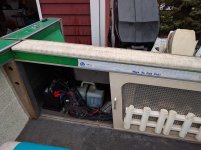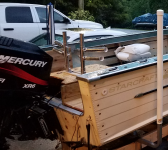jonnyfish
Petty Officer 3rd Class
- Joined
- Nov 28, 2016
- Messages
- 86
I've done a lot of digging around the iBoats forums, and internet more broadly to really comb through what people have done regarding the giant splashwells on these older boats. I also know a lot of people's position on this subject: it's structural, leave it like it is - if you don't like it find a new boat.
While I understand that position, respectfully I would say "no". I love my mariner, for it's size, it's incredibly light, yet fights big chop surprisingly well, it also has high walls that i love in that big chop. I've ridden in mine enough now that I know I really don't want to make the switch. Instead - I want to better understand how to solve this problem - which is the splashwell.
Background:
I'm a casting fisherman, and having as large and open of a layout as i can for a rear deck is absolutely ideal. In my rebuild i'm looking to create enough seating space for 4 seats, and a reasonably rear casting deck. i understand I have a number of options here and I am exploring them (jump seats, fold up bench seat, etc. etc.)
Even so, the splashwell is a waste of space, and I think Starcrafts newer mariners lean into this with better designs that seem to use that space better while supporting the transom and walls.
So diving in, here's a snap of the back of my boat, with the transom and splash well, it's what you'd expect, standard from starcraft mariner in the 70s:

So with this, what I think i'm understanding is that the forces put onto the transom are also being absorbed by this really giant splash well. Not only that, but I'm understanding this splash well is also providing lateral support for the high walls, probably in part because the transom is so low? With these items my take aways are:


So with these observations i get into the harder questions. How can I create a simpler, more efficient, and equally effective splash well for my boat? I took a wander around the internet to see what other examples and options i could find as it relates to this boat and its splash well.
Here are some interesting observations.
Newer mariner splash well:
80s: (edit: i dug around more and realized this is not the same model, so not apples to apples)

90s:

It looks to me that over the years the incrementally fixed the design flaw that forced their need or a large structural splash well. I would be satisfied settling for the splashwell from the 80s. My question is, how could that be done in a way that still supports those high walls, is it the rib braces i mentioned earlier? I'm honestly curious in the picture i included from an 80s build how those walls were supported, unless that angled approach with the dip is sufficient support when paired with the ribs. If it is, great! I honestly don't see that as an overly complicated fabrication. I do note that on the 80s mariner there is a slight change to the transom shape, and the sides are thicker than they are on the 70s version of the transom.
Now, here's one that i thought was -really- interesting.

So, I have all the questions here. It appears to be a 70s style mariner transom. but there is NO splash well. Does this actually work? Is there enough support for the forces exerted by the motor? Are the bench seats providing support for the walls? I'm pretty skeptical of this but wanted to get thoughts anyway.
In general, I think a question I have is if I'm serious about this (which I very much am), is changing the shape of the transom board a requirement? Or am I in a safe enough place if I ensure that the forces that require support are accounted for (motor, and walls).
If I am off in some of my thoughts here please do tell me, but I'll be clear, I'm very determined to do this, I love my mariner and want it to be my forever boat. This is truly the most challenging piece to overcome in my rebuild.
While I understand that position, respectfully I would say "no". I love my mariner, for it's size, it's incredibly light, yet fights big chop surprisingly well, it also has high walls that i love in that big chop. I've ridden in mine enough now that I know I really don't want to make the switch. Instead - I want to better understand how to solve this problem - which is the splashwell.
Background:
I'm a casting fisherman, and having as large and open of a layout as i can for a rear deck is absolutely ideal. In my rebuild i'm looking to create enough seating space for 4 seats, and a reasonably rear casting deck. i understand I have a number of options here and I am exploring them (jump seats, fold up bench seat, etc. etc.)
Even so, the splashwell is a waste of space, and I think Starcrafts newer mariners lean into this with better designs that seem to use that space better while supporting the transom and walls.
So diving in, here's a snap of the back of my boat, with the transom and splash well, it's what you'd expect, standard from starcraft mariner in the 70s:

So with this, what I think i'm understanding is that the forces put onto the transom are also being absorbed by this really giant splash well. Not only that, but I'm understanding this splash well is also providing lateral support for the high walls, probably in part because the transom is so low? With these items my take aways are:
- The splash well must lend support to the forces exerted by the outboard motor on the transom
- The splash well must lend support to the high walls that are otherwise poorly supported.


So with these observations i get into the harder questions. How can I create a simpler, more efficient, and equally effective splash well for my boat? I took a wander around the internet to see what other examples and options i could find as it relates to this boat and its splash well.
Here are some interesting observations.
Newer mariner splash well:
80s: (edit: i dug around more and realized this is not the same model, so not apples to apples)

90s:

It looks to me that over the years the incrementally fixed the design flaw that forced their need or a large structural splash well. I would be satisfied settling for the splashwell from the 80s. My question is, how could that be done in a way that still supports those high walls, is it the rib braces i mentioned earlier? I'm honestly curious in the picture i included from an 80s build how those walls were supported, unless that angled approach with the dip is sufficient support when paired with the ribs. If it is, great! I honestly don't see that as an overly complicated fabrication. I do note that on the 80s mariner there is a slight change to the transom shape, and the sides are thicker than they are on the 70s version of the transom.
Now, here's one that i thought was -really- interesting.

So, I have all the questions here. It appears to be a 70s style mariner transom. but there is NO splash well. Does this actually work? Is there enough support for the forces exerted by the motor? Are the bench seats providing support for the walls? I'm pretty skeptical of this but wanted to get thoughts anyway.
In general, I think a question I have is if I'm serious about this (which I very much am), is changing the shape of the transom board a requirement? Or am I in a safe enough place if I ensure that the forces that require support are accounted for (motor, and walls).
If I am off in some of my thoughts here please do tell me, but I'll be clear, I'm very determined to do this, I love my mariner and want it to be my forever boat. This is truly the most challenging piece to overcome in my rebuild.
Last edited:

























